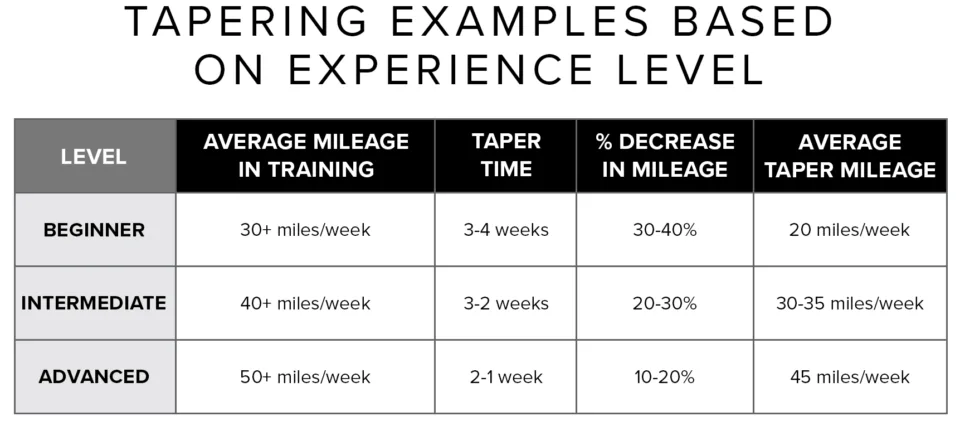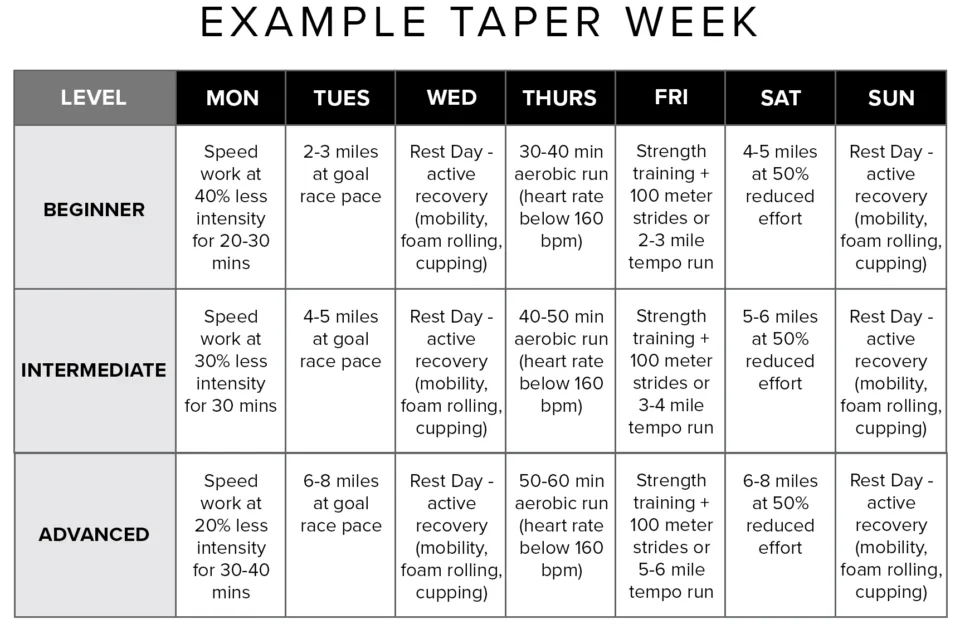Topics
- Article
- Running
How to Taper Before a Marathon Like a Pro

We discuss what a taper is, what it consists of, and how it can help you hit your marathon goal pace to get you across the finish line.
If you’re in the homestretch of your marathon training plan, nice work, you’ve already completed the bulk of your training! The longest run is over and now it’s time to get ready for race day. As a coach and a runner, I would be remiss not to mention how physically and mentally uncomfortable tapering can be. If you know, you know: Not running as much, especially after running at a high volume, can leave a lot to be desired from your body and mind. During my clients’ taper, I usually hear: “I feel like I should be doing more even though I know I'm supposed to be doing less.” Physically it’s common to feel lethargic too, which is not what you want on race day. Luckily, all of this is completely normal! Reducing volume and intensity is necessary for every marathon taper, regardless of the athlete’s pace. And while there isn't one “right formula” for everyone - a world-class athlete like Meb Keflezighi will usually taper for about 11 days out, while a less experienced runner will take anywhere from 3-4 weeks to taper - there are tips and guidelines you can use to get the most out of it.
What Tapering is and Why it’s Important
The goal of the marathon taper is to preserve the neurological and physiological adaptations you’ve already acquired throughout your training in the past months. This is accomplished by reducing volume (miles) and intensity (effort) in the last few weeks leading up to your race. Don’t get it twisted though, those past few months of grueling workouts weren’t for nothing! The progress you’ve made doesn’t disappear overnight. The taper typically falls on the weeks following the longest run in your marathon training cycle. The average marathon training cycle lasts anywhere from 16-20 weeks, based on your level of experience (20 weeks being for less experienced runners). Tapering, depending on the duration of the training cycle, can range anywhere from the final 3-4 weeks leading up to race day (for more novice runners), to just the last 1-2 weeks. In these last few weeks the mileage and intensity can decrease anywhere from 10-40%, depending on the athlete’s level of fitness.

Your level of experience determines how much you should taper before a marathon.
The general gist? Cut back your volume and intensity so your body is prepared to handle a high strain on race day. The demanding, high-effort, high-mileage workouts are already behind you. All you have to do from here is maintain your baseline. In WHOOP terminology, stay “in the green” with your daily recovery as best you can during the weeks leading up to your race. So yes, you can still run. In fact, you need to. You can even do speed work or lift, just remember at this point less is more. For example, instead of doing half or quarter repeats, maybe you do 100-meter strides.
Study of Effective vs Ineffective Tapering
Here’s an example of an effective approach to tapering: A research study was conducted on 11 triathletes during 3 months of training interspersed with 2 taper periods, one of 10 days (Taper 1) and another 6 weeks later for 13 days (Taper 2). Reducing training volume by 50% in an exponential fashion in one group of triathletes during Taper 1 resulted in a 46-second (4%) improvement in their 5 km criterion run time, and a 23-Watt (5%) increase in maximal ramp power output above the same measurement at the beginning of taper. On the other hand, a 30% step reduction in training volume in the second group did not result in any significant improvement in physical performance on the same measures. This study shows a clear correlation between performance and tapering. The athletes with a 50% reduction in training load yielded better performance results than the athletes who only had a 30% decrease.
The most common mistake runners make during their taper
I’ve witnessed it with athletes I’ve trained, and I’m guilty of it myself: The most common mistake runners usually make while tapering is doing those “extra few workouts” in the weeks leading up to race day. Why do we tend to do this? Because our fear of “losing fitness” during the taper can be real. But while those extra few workouts may be temporarily mentally satisfying, they come with a cost. My best advice? Keep training, just scale back intensity. Human performance works like a battery, to save power you have to decrease output. Tapering is basically maintenance. The golden rule for fresh legs and a clear head on race day is to get behind the starting line with a full tank. The additional workouts you feel you need to do during the taper aren’t the answer to nailing your goal marathon pace. The work has already been put in, now it’s time to recover, prepare, and preserve.
The mental side of tapering
Tapering is both mental and physical. Your success depends on two factors: 1) How primed your body is to perform 2) The collective feedback from your training Collective feedback is your interpretation of both objective and subjective feedback from your training. Objective feedback being pace and mileage; subjective feedback being emotions, effort, or pain. When you run, your body sends signals to your brain and how you interpret those signals often determines the outcome of your run. Running is an activity for the body and mind, it requires both mental and physical endurance. Now let’s be real, how many runs have you had where you tell yourself, “Today, I will run at an easy effort,” but then you end up with a new personal best? It can happen to all of us. Runners often base pace off perceived effort, but perceived effort isn’t always in line with what we should be doing in terms of intensity. Physically, workouts during your taper should feel like you can “do more,” or push harder, but you don’t. This requires patience. Well-rounded distance runners have a strong sense of self-awareness, confidence, and self-control, which is a great mentality. They also tend to have another trait in common–relentless forward progression. The only way out is through. Pretty badass if you ask me, but save that energy and mentality for race day. Tapering is a time to practice self-awareness and patience. The neurological and physiological adaptations your body needs for race day have already been acquired in the past few months of training. Be confident in that. Seriously. Leading up to the race, focus less on objective goals like pace or time, and put the focus on improving your general state of well-being. Ask yourself, “What can I do to train my brain today to optimize my performance for my race?” Remember the battery metaphor I gave you earlier, if you want to preserve power, decrease output.
What’s tapering too much and what’s too little?
Another common mistake people make while tapering is resting too much. Recovery requires movement. Just not as much movement. Which leads me to my next point, that the tough part about tapering is knowing what’s too much and what’s too little. I hate to say it, but the best way to figure this out is through trial and error. A runner who is aiming for a sub 3-hour marathon finish will have an entirely different taper plan than someone who’s aiming for closer to a 4-hour finish.

A typical training week during the taper period just before a marathon, based on experience level.
Actionable Recovery Tips While Tapering
Now that you’re not spending as much time and effort on training, you can fill up that spare time up with mobility work, injury-prevention drills, easy paced runs, and preparation–like what you’re going to wear and other race-day logistics. This not only eliminates room for error during your race, but also keeps the forward momentum. Rolling: IT band syndrome and runner’s knee are the most common overuse injuries amongst distance runners. The IT band doesn’t stretch though, so don’t waste your time static stretching. Oftentimes, knee pain is a result of ITBS. I suggest using a tennis or golf ball, or do trigger point of foam rolling. This allows for more accurate, pinpointed, release of the muscles which are tight. Do this every day until race day. Ice baths: Enable blood vessels to constrict which reduces inflammation and aids in repairing broken down muscle tissue (15 minutes max, 2-3 times a week). Epsom salt baths: Increase blood flow to muscles (do these 2-3 times a week). Cupping: Releasing the muscles from the bone improves blood flow which allows for nutrient delivery to increase. IV vitamin and hydration shots: This is a great way to ensure your body has all the hydration, and vitamins and minerals it needs to perform. Sleep: Now more than ever is a great time to make sure you’re getting your best sleep! MORE FROM COACH MEG: How Often Should You Run? Tips for Running in Cold Weather And check out runwithmeg.com.